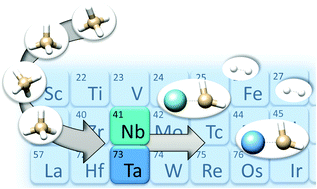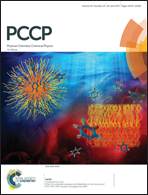Direct and cluster-assisted dehydrogenation of methane by Nb+ and Ta+: a theoretical investigation
Abstract
DFT calculations have been performed to examine both direct and cluster-assisted methane C–H bond activation by Nb+ and Ta+ cations. The commonly accepted dehydrogenation pathways, that are oxidative addition and reductive elimination, have been studied in detail for methane ligated clusters M(CH4)n+ (M = Nb, Ta and n = 1–4). For the second H atom transfer to the metal in the presence of additional CH4 molecules (n > 1) two alternative routes have been explored. Energy profiles for ground quintet and excited triplet and singlet spin states of both Nb+ and Ta+ cations have been calculated. Spin crossings occur for all the examined pathways. Clustering of methane ligands appears to favorably affect the process stabilizing all the intercepted minima and transition states and bringing all the calculated PESs below the reference energy of the separated reactants. The direct activation of methane (n = 1) can proceed efficiently only for Ta+, whereas dehydrogenation is endothermic for Nb+ by 9.0 kcal mol−1. When assisted by additional methane ligands, the dehydrogenation process becomes exothermic for both cations whatever the number of coordinated molecules.



 Please wait while we load your content...
Please wait while we load your content...